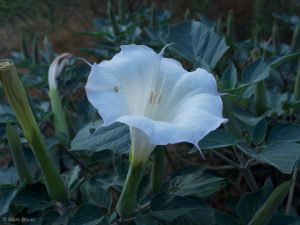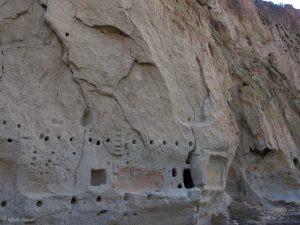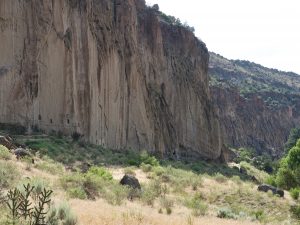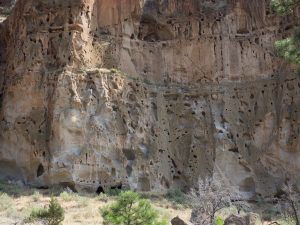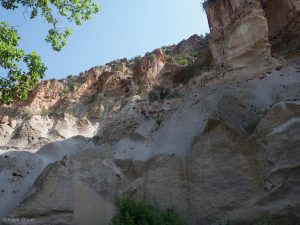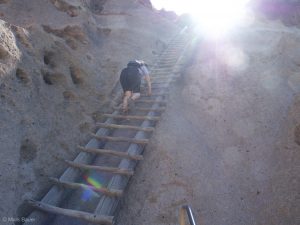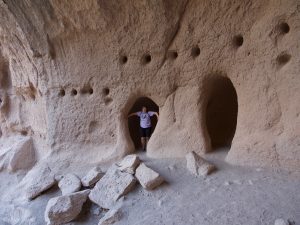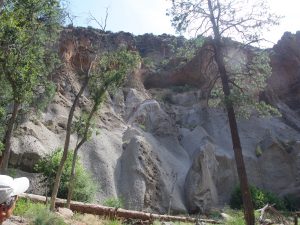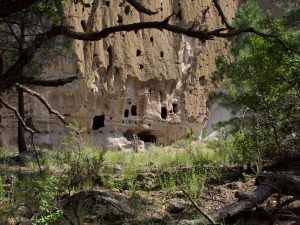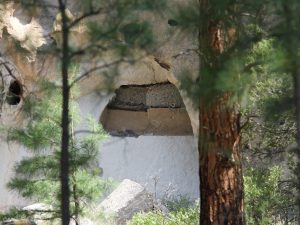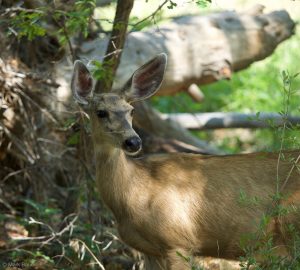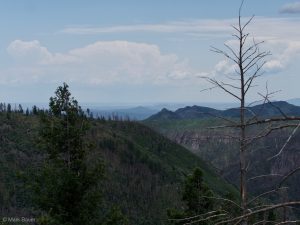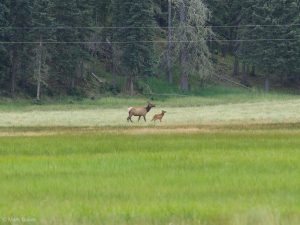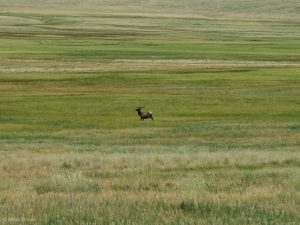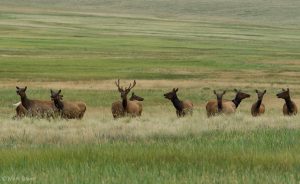We were again on the road early, excited to explore the various areas near Los Alamos that Randy (who grew up there and has been back many times) had told us about, and that were all brand new to us. We started out by driving to Bandolier National Monument, where there are cliff dwellings and canyon floor villages built by Ancestral Pueblo people, just like in Mesa Verde–except that in Bandolier, the canyon walls are super-soft tuff from the volcanic explosion that formed the nearby Valles Caldera, full of fantastically shaped holes and mini caves, and easily carved by the people. So the people who built here used fewer walls and carved more of their dwellings (in some cases, exclusively carved them) into the cliff side. And more of their buildings, although used into the 1500s here, have eroded and disappeared. But they used the same style of building as the Mesa Verde people: small, multi-story “apartment buildings” with wooden floors/ceilings (the beam holes are a good sign of a building complex), plus kivas, and they used adobe wall “paint” and often had petroglyphs on the walls above the buildings. What was fun about the little self-guided tour we took was that there was climbing and close-up exploring (although much of what we saw was partially reconstructed) and the add-on to the tour was a walk to the so-called Alcove House, which has huge long ladders and sits much, much higher in the cliffs than the other dwellings, which tend to start at the ground level. On the way to Alcove House, we spotted many other sites and on the way back, along a nature trail, we saw a mule deer that got very close to us and was obviously not afraid of people at all.
We wrapped our visit up by having our picnic at about 11:30 in their lovely visitor center plaza, and then drove out of the Bandolier area on the west side. We took a small hike (2.5 miles) to a canyon overview and then continued into the Valles Caldera area, where there is an access road to the huge big meadow that is only about a fourth of the caldera. I am still trying hard to imagine how high that volcano would have been for this caldera to be left–it is smaller than the Yellowstone caldera, of course, but the volcanic eruption was still the second-largest of the big eruptions that shaped the North American geology so massively.We drove about 5 miles further in past the visitor center (which took a back country permit, but that makes us sound much more adventurous than we were!), and watched for wild life on this vast pale green expanse. Eventually, we saw both an elk mom and her baby and a larger but very undecisive herd of elk. We watched them all turn one way and move off into that direction, then hesitate and confer, and do it over again in another direction.
By the time we left the caldera, it was after 3 pm; we backtracked a little bit and then took a road north to nearby Los Alamos. We caught the ranger at the visitor center just as he was closing at 4 pm, and he still gave us maps and chatted a bit; it turned out that he used to work for a company in Hastings! Small world. Then we went over to the Bradbury Science Museum, where various displays talked about the beginning of Los Alamos (i.e. the creation of the atomic bomb and necessary technology for getting ready to drop it on Japan), as well as current research that goes on there, plus a little of this and a little of that (development of the computer; testing of explosives; the nature of radiation, nanotechnology), all very hip and shiny and interactive, but also emphatically not the least bit skeptical about the decision to use the bomb and kill 280,000 people with two bombs. We were actually more curious about what we did after we left the museum, i.e. take the little walking tour through the limited remnants of the “old” Los Alamos from the 1940s that are still there–they are very limited, since the research area (“1”) was actually razed later on, so it’s the rather snazzy homes where the scientists (Oppenheimer, Bethe, and the like) lived, for the most part in buildings that were part of the Ranch School that had been there before. There is also the Lodge where everyone met for social events, and a cafeteria that was used in the 1940s–but that’s about it. We were especially interested because we recently started reading an account of what it was like to be there as part of the science team, by Richard Feynman, who was there in a minor role but was suspected of being a spy because he left for Albuquerque a lot (his wife had TB and lived there in a sanatorium). And of course because Randy had several stories about growing up there in the 1960s. But the town is really not recognizable as the little unknown spot in the middle of nowhere that the scientists came to in the 1940s.
We left the area about 5 pm, and drove home in a bit of rain–we’d been watching it rain and even heard thunder elsewhere nearby pretty much all afternoon, but although we could sometimes see sheets of rain going down in the distance, it had never caught up with us. We drove through the rain, though (Santa Fe was dry) and got home at about 6 pm. We chatted a bit with Randy and Laurie, and then had a simple but yummy pub food dinner at the nearby Fire and Hops bar (risotto for me, a burger for Mark, and a shared dish of the owners’ celebrated ice cream–they also own an ice cream store in town, and specialize in unusual flavors: we had gingersnap, brown butter and hops, and white-chocolate cashew, all of which were good). Then we sat in the nice cool breeze a bit more and are now wrapping up the day.
